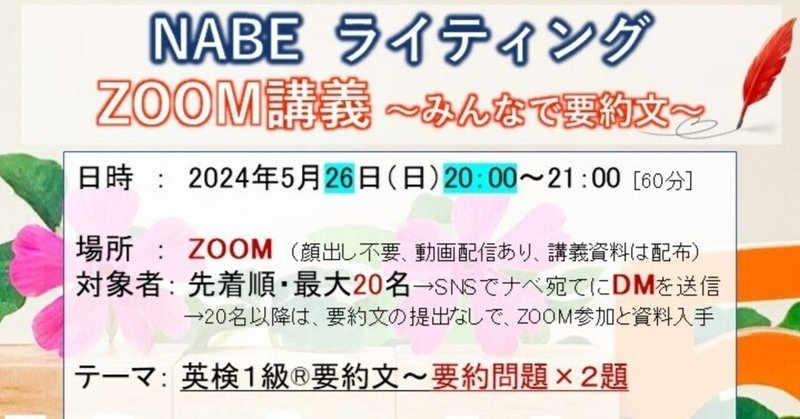
<講義後(動画あり)~5/26(日)20時~ZOOM講義~みんなで要約文>
1.はじめに
<5/26(日)朝7時、追記>
講義用資料ドラフト・・・提出された要約文の添削付き、を公開しますので、必要な方は、各自、ダウンロードの上、確認をお願いします
<5/22(水)追記>
提出して頂いた要約文を、そのままコピペしたWordファイルを、6項の講義資料(ドラフト版)に貼り付けました
<5/12:注記>
2024年5月12日(日)時点で、参加希望者が20名を超えています。また、20名以降の方には、「要約文の提出なし」だが「ZOOM講義には参加」にて、ご理解頂いております。
ついては、今後、このnote記事を購入頂く方は、「要約文の提出なし」とご理解をお願いします(ナベ)
*****************
このたびは、ナベのZOOM講義~みんなで要約文に興味をもって頂き、ありがとうございます。
以下のとおり、ZOOM講義の要領をお伝えしますので、参加希望の方は、お手数ですが、ナベにSNSで事前連絡して、ナベから
「受講番号」
を入手した上で、このnote記事を、事前に購入頂きますよう、お願いします。
X(Twitter):Nabe_English@NabeEnglish (富士山でのご来光の写真)
Instagram :Nabe_English
→ ナベも、無制限に要約文を添削できないので、先着20名(+α)の番号を、それぞれの方にお伝えして、要約文を提出してもらう方の人数をカウントさせてもらいます。
なお、事情により、noteを購入できない方には、クレジットカード決済やPayPay送金でも対応させて頂きますので、ナベのSNSまで、気軽に連絡してもらえればと思います。
また、note機能をフル活用して、以下の5~9項の情報を段階的に公開していきます。
2.講義の内容
日時・場所
2024年5月26日(日)20:00~21:00、ZOOMのみ(顔出し不要)
講義内容: 英検1級®要約文~要約問題×2題
第1部: 要約問題(全般) 最新情報を幾つか共有します
第2部: みんなで要約文+Q&Aセッション
・要約文の提出期間: 5/11(土)~5/19(日)
→2種類の課題文のうち、1つを選択して提出
・ナベの添削期間: 5/20(月)~5/25(土)
・講義資料ドラフト配布: 5/26(日)午前
・提出してもらった要約文を無記名で簡易解説します
(講義後、複数の要約文を比較検討できます)

3.要約問題の提出方法
先着20名の方は、以下の2つの課題文から、どちらかを選んで、その課題文を、ナベのパソコンメールまで送付願います
takashi_watanabe0522@yahoo.co.jp (takashiの後ろは、アンダーバー)
なお、メールの件名は、以下の形式で、ご協力をお願いします
件名: みんなで要約文の提出、課題文1か2、SNSのアカウント名
本文: 課題文は、メール本文に、そのまま貼り付けてほしいです(ナベにてwordファイルに転記させてもらいます)
なお、要約文の提出に際して、ナベの受信漏れを防ぐために、パソコンメールに要約文を提出した後、「提出しました!」とDMを送ってもらえると助かります。
4.2つの課題文
課題文1、Title: Addressing Land Subsidence in Italian Cities
Title: Addressing Land Subsidence in Italian Cities
Land subsidence represents a critical challenge for historical Italian cities like Venice and Florence, where excessive groundwater extraction to meet, urban demands has led to significant ground sinking. This phenomenon threatens the structural integrity of ancient buildings and escalates flood risks, which is especially problematic in regions with soft, alluvial soils prone to settling. In response, cities have implemented robust engineering solutions and regulatory measures, including stringent restrictions on groundwater extraction to stabilize the soil and preserve the unique urban landscape.
To complement these strategies, innovative urban planning now mandates detailed geological assessments prior to the approval of new construction projects. This proactive approach ensures that any new development is fully compatible with the delicate subsurface conditions, aiming to minimize further subsidence risks. Moreover, cities are increasingly relying on advanced monitoring technologies, utilizing satellite data and ground sensors to track land movements with high precision. This data is vital for city planners and engineers, allowing them to implement timely interventions that can forestall minor subsidence issues from escalating into severe problems.
Despite these concerted efforts, the battle against land subsidence in Italy is ongoing. The complexity of the issue demands continuous adaptation and innovation in both engineering and urban planning. As urban populations grow and environmental challenges intensify, sustainable management of natural resources and the preservation of historical heritage remain paramount. These efforts are not only crucial for protecting Italy’s cultural legacy but also for ensuring the long-term viability and safety of its historic urban environments.
(Word Count: 246)
課題文2:
Title: Considering a Heritage Preservation Fee in Kyoto, Japan
Kyoto, Japan, celebrated for its rich tapestry of ancient temples and cultural heritage, is contemplating the implementation of a heritage preservation fee to counteract the effects of its substantial tourist influx, attracting approximately 50 million visitors annually. The proposed fee, set at 500 yen, is designed to help manage issues such as environmental degradation and the displacement of local communities, which are exacerbated by rising property prices due to overtourism. The fee is planned primarily for peak tourist seasons and weekends, aiming to curtail visitor numbers and provide funds for the maintenance and enhancement of historical sites.
The proposal has met with skepticism from many local stakeholders who worry that it might discourage tourism, a crucial economic driver for the city. The debate is intense among residents and business owners regarding the fee's potential impact, particularly its disproportionate effect on day-trippers versus overnight guests. Some locals have begun voicing their concerns through protests, arguing that the fee is merely a temporary fix that does not address the underlying issues of sustainable tourism management and the preservation of the environment. They are calling for more robust measures, such as imposing limits on the number of tourists during peak times and encouraging visits during less busy periods.
As Kyoto faces significant challenges in preserving its historical assets amid ongoing tourist pressure, the discussion around the heritage preservation fee highlights the city's struggle to balance economic dependency on tourism with the imperative to safeguard its cultural and environmental integrity. This fee, if implemented, could mark a critical step in Kyoto's efforts to manage its resources sustainably, ensuring that its historical sites are protected for future generations while maintaining its appeal as a top global destination.
(Word Count: 282)
(以下が、有料部分)
ここから先は
¥ 800
この記事が気に入ったらサポートをしてみませんか?
